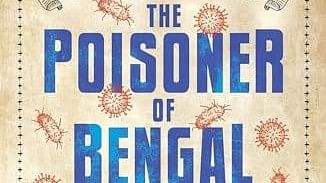
In November 1933, 22-year-old Amarendra Chandra Pandey, a young man from a family of zamindars in a town called Pakur, feels a pinprick at Howrah, Calcutta’s (now Kolkata) busiest railway station. Within days, Amarendra succumbs to the prick but what unravels in the next few months is a tale of murder most foul, deception, rivalry and greed.
Amarendra is injected with the plague serum by someone hired by his elder brother Benoyendra Chandra Pandey. The elder brother’s accomplices include Taranath Bhattacharjee, a small-time doctor and friend, Shivapada Bhattacharjee, an assistant professor at the Calcutta School of Tropical Medicine and Durga Ratan Dhar, a fellow of the Royal College of Physicians.
This book is not so much a whodunnit but a howdunnit, a reconstruction of how the accused went about the murder. The murder also led to a prolonged trial that started in July 1934 the verdict of which was announced in February 1935 (death by hanging for Benoy and Taranath). The trial was covered on the front page of the New York Times. Eventually, the sentence was commuted to life imprisonment.
This sensational murder case called the Pakur murder case, a town in present-day Jharkhand, drew the attention of one-time American crime reporter and now deputy world editor at USA Today Dan Morrison. The well-researched book draws on printed trial records, official memoranda, telegrams, reports and handwritten notes written in the margins of the then Government of Bihar’s file on the murder. The author’s interest in researching cholera, plague and the history of medicine was what led him to this ‘murder by plague’. Morrison’s journalistic experience has served him well in his narration of the case.
The author establishes the scene of the crime early on — Howrah Station. He then takes his time to peel the layers of this fratricide, delving into the family dynamics of Amarendra Pandey, the societal trends of that time, and even the cinema of the 1930s.
A chapter is dedicated to Sherlock Holmes’ mysteries and the time when Indian readers first got a taste of the fictional British detective. Could Benoyendra have been inspired by the short story by Sir Arthur Conan Doyle, ‘The Adventure of the Dying Detective’?
Doyle’s story is centred around a greedy colonial planter and amateur bacteriologist who kills his nephew with an unknown germ planted in a pointed tip of steel spring, inside a gift box. Or could Benoyendra have been inspired by Sherlock Holmes’ silent films such as ‘The Dying Detective’, starring English stage actor Ellie Norwood? There are plenty of cinema-related tidbits throughout the book — for instance, that British India had 300 movie houses by 1928 and that over 8,000 foreign films were screened in India between 1920 and 1927.
In contrast, there were just over 900 domestic productions. What is cinema doing in a recounting of a true crime story, you wonder. But the references to cinema are not without reason. Benoyendra, the elder brother, saw himself as a “potential saviour of the Indian film business.”
Attention to detail
The setting of the stage, the locations (Pakur, Calcutta, Bombay) and character sketches of those involved in this crime are done with great attention to detail. While the book is full of what we refer to as #TIL moments in social media parlance (‘Today I Learned’) and research is its strong suit, the many asides also hamper the flow, and at some points, appear to be unnecessary.
The reconstruction of the murder and the trial that follows takes us through a lot of history related to the plague pandemic and the work of the Haffkine Institute for Plague Research in the then Bombay. There are plenty of plague-related anecdotes as well — the story of an Austrian visitor drowning while running away from a gang that misconstrued his handbag for the plague vaccination kit is one such.
The account of the murder goes back and forth, tracking Benoyendra’s attempts at getting his brother infected, including one instance of the accused trying to infect Amarendra with tetanus and succeeding. The narration of Benoyendra trying to procure white rats from Bombay’s Crawford Market to hand over to his friend and doctor Taranath Bhattacharjee is pacy and engaging. The post-trial events leading to Benoyendra’s death make it a gripping read. One also comes across several nuggets about the history of the Pakur region.
If you love both history and true crime, The Poisoner of Bengal is just the book for you, with its many ‘aha’ moments. Also, if you are a quizzer or love trivia, the book is a treasure trove of information.